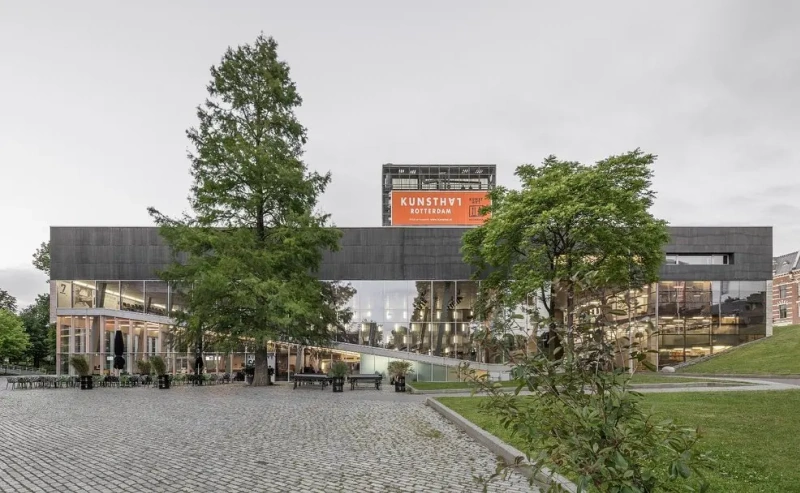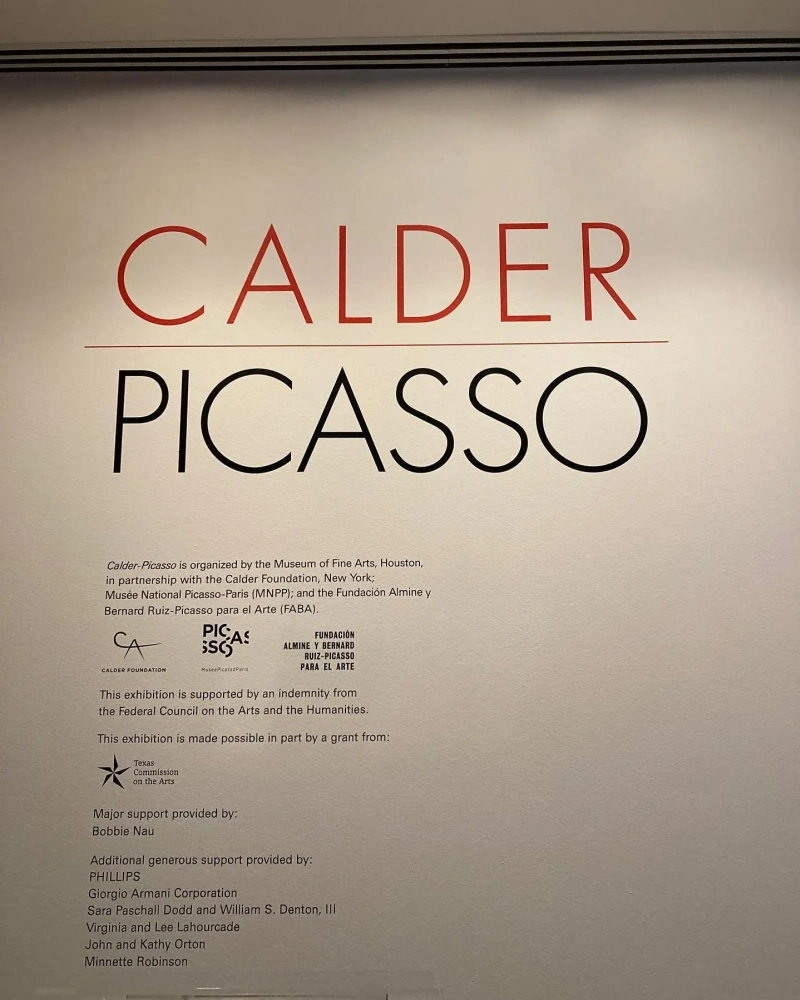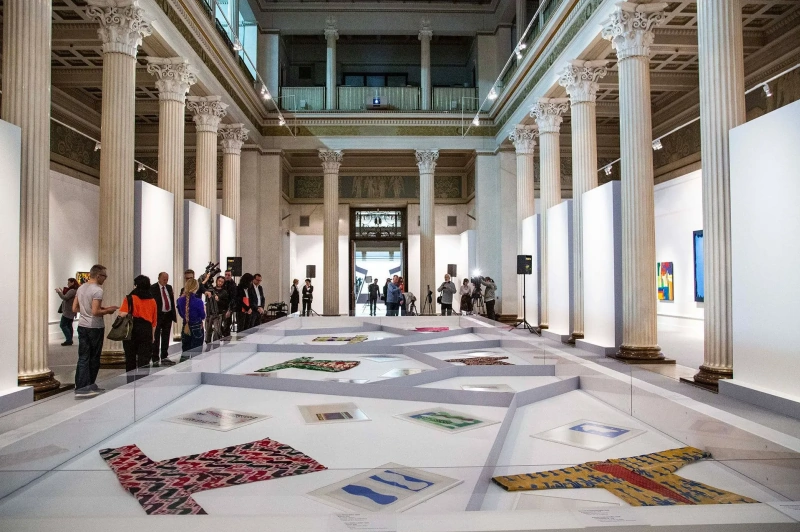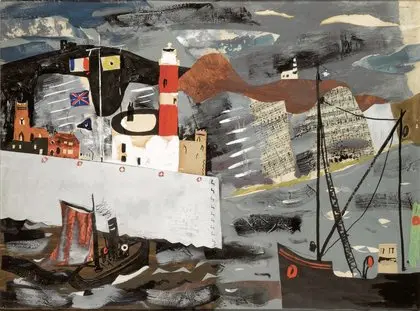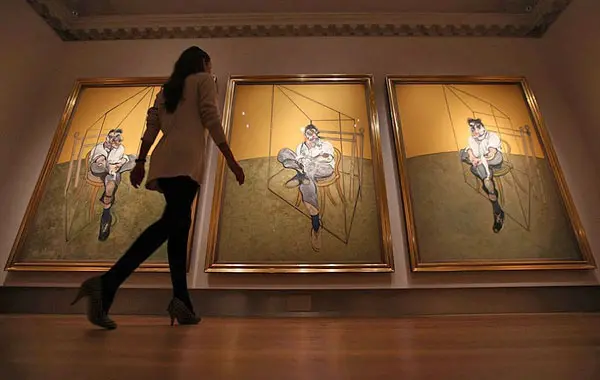log in
Enter site
Login to use Arthive functionality to the maximum
Alexander Calder (English Alexander Calder, July 22, 1898, Lonton, USA - November 11, 1976, New York, USA) - American sculptor, inventor of the so-called drawing in space and famous mobiles - movable sculptures, which were set in motion by air currents.
Features of the work of the sculptor Alexander Calder: they glorified Alexander Calder with wire sculptures - it seemed that he was drawing figures of people and animals with wire in space. But once he saw one dayPete Mondrian lays out colored geometric shapes on the surface of the table, achieving a balance of composition, as Calder realized that abstract figures and elements are enough for creativity - and the figurative stage of creativity was left behind for him. A talented engineer and practitioner, Calder comes up with complex suspension structures that are balanced by accurate miscalculations, but sway soothingly from the slightest air movement. Later, the mobiles that Calder invented could be found in almost every home.
Famous works of Alexander Calder: “Calder’s Circus”, “Mobile”, “Mercury Fountain”, “High Speed”
In fact, Alexander Calder, although born in a family of hereditary artists and sculptors, was not going to connect his life with art. He received an engineering degree from the Stevens Institute of Technology, and then enthusiastically and responsibly worked in the automotive industry, in a logging camp, on a passenger liner.
Calder survived two world wars and was an active opponent of the Vietnam War - because of this position, he refused to receive the Presidential Medal of Freedom, but several events really changed his life: two weeks spent in the Ringlin Brothers Circus, a visit Pete Mondrian’s workshop and sunrise on one horizon, while on the other horizon in the sky was a full moon. This last event was actually the first - Alexander Calder, then an engineer, sailed on a ship and met morning on a deck off the coast of Guatemala, when he suddenly saw the sun and moon at the same time. He finished the flight, got off the ship and decided to become an artist.
And three years later there was a circus: Calder then worked as an illustrator in a newspaper and was sent for several weeks to the circus - to make sketches. After that, he created the first work of art - Calder's circus. It was a mockup of an arena with figures, in which the author, for two hours, moving the figures with his hands, played out a performance. This protoperformance was incredibly popular in artistic circles.
Another 5 years passed, it was 1930, and Calder got into the workshop of Pete Mondrian. He recalled this as the most important experience:“It was a very impressive room. It was illuminated on the left and on the right, and throughout the wall between the windows were colored cardboard rectangles that formed into some kind of experimental group. I noticed that it would be nice if these rectangles moved. And Mondrian with a very serious expression on his face said: "No, this is not necessary, my picture is already quite fast."This one visit made a deafening blow on me.printing, then it all started. ” Then Calder came up with the idea that his sculptures should move. Engineering education, of course, was very useful to him. A year later, he created the first movable sculpture, andMarcel Duchamp called her a mobile. In the same year, Alexander met his future wife, with whom he would live until the end of his life, in one of the many voyages across the Atlantic Ocean (America-France, France-America).
After returning to America in 1933, Alexander Calder did not have periods of downtime or creative decline. His biographies, divided into decades, invariably begin with the phrase "this period was very productive for the sculptor." He collaborated with the Pierre Matisse Gallery, very quickly engaged in monumental sculptures for urban space. During World War II, due to a shortage of metal, he works with wood and metal trimmings, almost rubbish - and still, in 1943, the Museum of Modern Art in New York hosts its huge retrospective exhibition. In the 50s he was engaged mainly in large orders: sculptures for airports, stadiums, exhibition centers, city squares and administrations. In the 60s, two American galleries, with which Calder collaborates, hold his solo exhibitions every year. He created several thousand jewelry made of wire - and his customers were the most famous women collectors.
Alexander Calder received the posthumous Presidential Freedom Prize. He is considered the founder of the direction of kinetic sculpture, although he himself never attributed himself to any direction - he just twisted his wire loops all his life, hung colored plates and watched the perfectly balanced compositions swaying hardly air.
Read more
Features of the work of the sculptor Alexander Calder: they glorified Alexander Calder with wire sculptures - it seemed that he was drawing figures of people and animals with wire in space. But once he saw one dayPete Mondrian lays out colored geometric shapes on the surface of the table, achieving a balance of composition, as Calder realized that abstract figures and elements are enough for creativity - and the figurative stage of creativity was left behind for him. A talented engineer and practitioner, Calder comes up with complex suspension structures that are balanced by accurate miscalculations, but sway soothingly from the slightest air movement. Later, the mobiles that Calder invented could be found in almost every home.
Famous works of Alexander Calder: “Calder’s Circus”, “Mobile”, “Mercury Fountain”, “High Speed”
In fact, Alexander Calder, although born in a family of hereditary artists and sculptors, was not going to connect his life with art. He received an engineering degree from the Stevens Institute of Technology, and then enthusiastically and responsibly worked in the automotive industry, in a logging camp, on a passenger liner.
Calder survived two world wars and was an active opponent of the Vietnam War - because of this position, he refused to receive the Presidential Medal of Freedom, but several events really changed his life: two weeks spent in the Ringlin Brothers Circus, a visit Pete Mondrian’s workshop and sunrise on one horizon, while on the other horizon in the sky was a full moon. This last event was actually the first - Alexander Calder, then an engineer, sailed on a ship and met morning on a deck off the coast of Guatemala, when he suddenly saw the sun and moon at the same time. He finished the flight, got off the ship and decided to become an artist.
And three years later there was a circus: Calder then worked as an illustrator in a newspaper and was sent for several weeks to the circus - to make sketches. After that, he created the first work of art - Calder's circus. It was a mockup of an arena with figures, in which the author, for two hours, moving the figures with his hands, played out a performance. This protoperformance was incredibly popular in artistic circles.
Another 5 years passed, it was 1930, and Calder got into the workshop of Pete Mondrian. He recalled this as the most important experience:“It was a very impressive room. It was illuminated on the left and on the right, and throughout the wall between the windows were colored cardboard rectangles that formed into some kind of experimental group. I noticed that it would be nice if these rectangles moved. And Mondrian with a very serious expression on his face said: "No, this is not necessary, my picture is already quite fast."This one visit made a deafening blow on me.printing, then it all started. ” Then Calder came up with the idea that his sculptures should move. Engineering education, of course, was very useful to him. A year later, he created the first movable sculpture, andMarcel Duchamp called her a mobile. In the same year, Alexander met his future wife, with whom he would live until the end of his life, in one of the many voyages across the Atlantic Ocean (America-France, France-America).
After returning to America in 1933, Alexander Calder did not have periods of downtime or creative decline. His biographies, divided into decades, invariably begin with the phrase "this period was very productive for the sculptor." He collaborated with the Pierre Matisse Gallery, very quickly engaged in monumental sculptures for urban space. During World War II, due to a shortage of metal, he works with wood and metal trimmings, almost rubbish - and still, in 1943, the Museum of Modern Art in New York hosts its huge retrospective exhibition. In the 50s he was engaged mainly in large orders: sculptures for airports, stadiums, exhibition centers, city squares and administrations. In the 60s, two American galleries, with which Calder collaborates, hold his solo exhibitions every year. He created several thousand jewelry made of wire - and his customers were the most famous women collectors.
Alexander Calder received the posthumous Presidential Freedom Prize. He is considered the founder of the direction of kinetic sculpture, although he himself never attributed himself to any direction - he just twisted his wire loops all his life, hung colored plates and watched the perfectly balanced compositions swaying hardly air.
-
Artworks liked by4 users
- Artworks in 1 collection and 7 selections
Publication
Exhibitions
All exhibitions of the artistFeed
Alexander Calder: Modern from the beginningexhibition finished

March 14, 2022 − January 16, 2023 The New York Museum of Modern Art (MoMA), 11 West 53rd Street, New York City
Calder todayexhibition finished

November 21, 2021 − May 29, 2022 Kunsthal Rotterdam, Museumpark, Westzeedijk 341, Rotterdam





